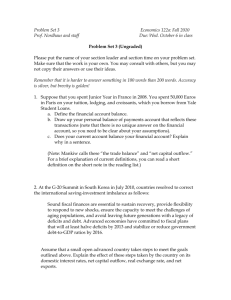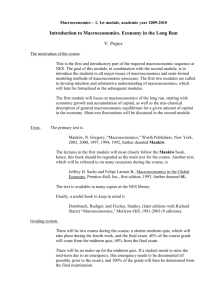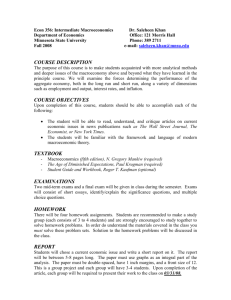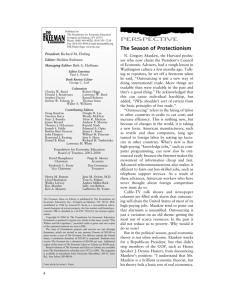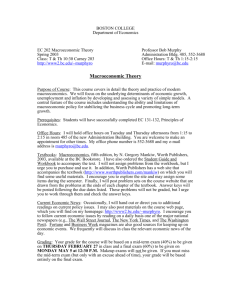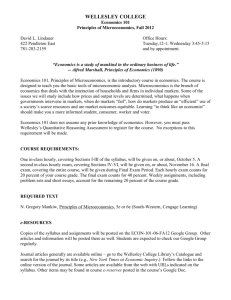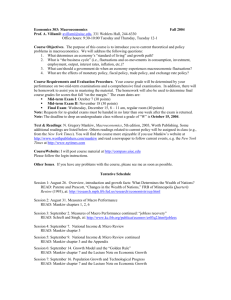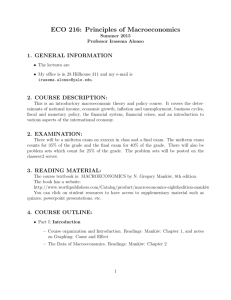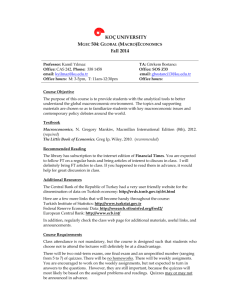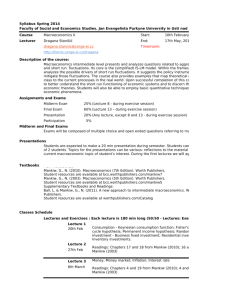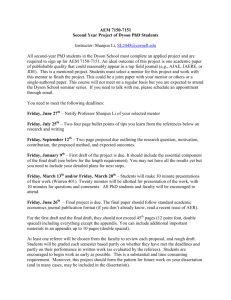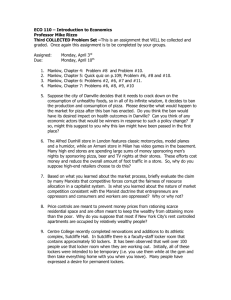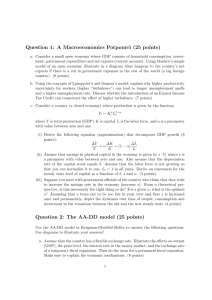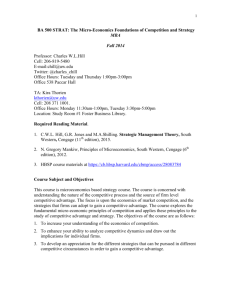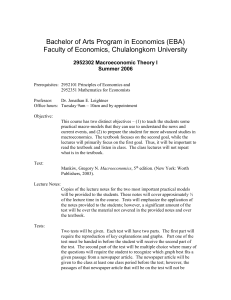Econ122a_2011_RL_091911
advertisement
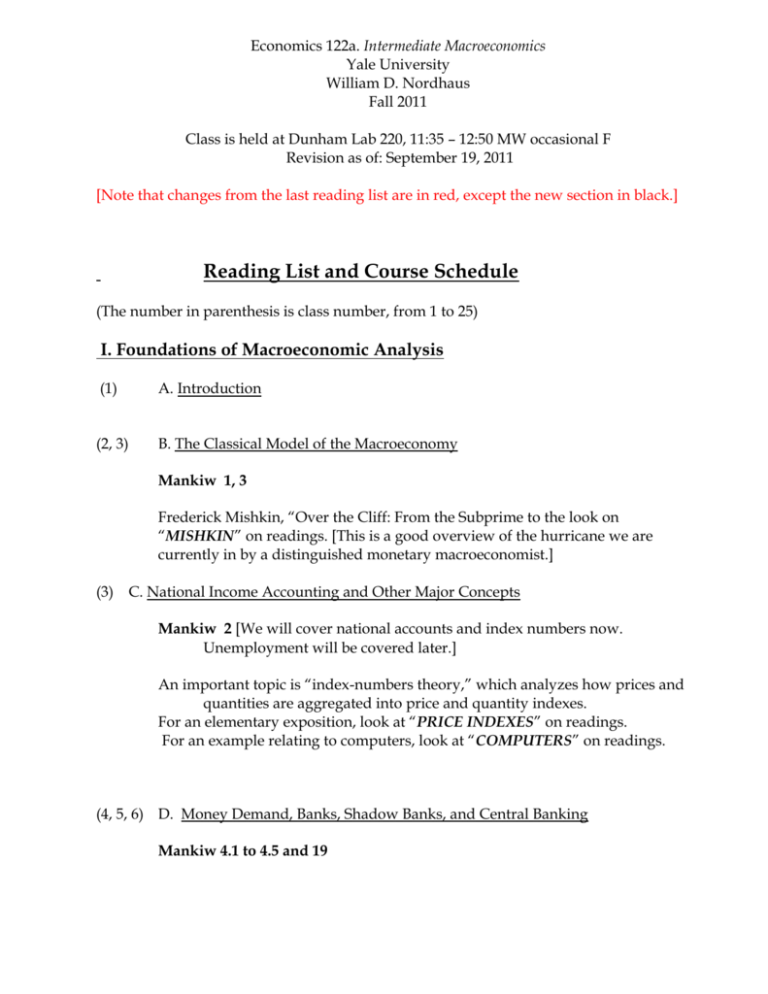
Economics 122a. Intermediate Macroeconomics Yale University William D. Nordhaus Fall 2011 Class is held at Dunham Lab 220, 11:35 – 12:50 MW occasional F Revision as of: September 19, 2011 [Note that changes from the last reading list are in red, except the new section in black.] Reading List and Course Schedule (The number in parenthesis is class number, from 1 to 25) I. Foundations of Macroeconomic Analysis (1) A. Introduction (2, 3) B. The Classical Model of the Macroeconomy Mankiw 1, 3 Frederick Mishkin, “Over the Cliff: From the Subprime to the look on “MISHKIN” on readings. [This is a good overview of the hurricane we are currently in by a distinguished monetary macroeconomist.] (3) C. National Income Accounting and Other Major Concepts Mankiw 2 [We will cover national accounts and index numbers now. Unemployment will be covered later.] An important topic is “index-numbers theory,” which analyzes how prices and quantities are aggregated into price and quantity indexes. For an elementary exposition, look at “PRICE INDEXES” on readings. For an example relating to computers, look at “COMPUTERS” on readings. (4, 5, 6) D. Money Demand, Banks, Shadow Banks, and Central Banking Mankiw 4.1 to 4.5 and 19 Most macro texts today deal with commercial banks (like Bank of America) but omit the “shadow banking system” like Goldman or AIG. This is a major topic for those interested in finance and financial macroeconomics. You can get the flavor of the shadow banking system in a paper by Yale profs Gary Gorton and Andrew Metrick, “Regulating the Shadow Banking System,” Brookings Papers, 2010, read “GORTON” in readings. You should read pp. 261-283. Also, read the appendix pp. 290-292 for the terminology. (7) E. Panics Problem set 1 due in class on Wednesday Sept 21 (class 7) One of the most important phenomena in financial markets is “panics.” These are examples of an important phenomenon in which there are multiple equilibria, tipping points, and strange behavior. These used to occur in the U.S. banking system and now occur in investment banking firms (Bear, Lehman), insurance companies (AIG), and even financially stressed countries (Iceland, Greece, …). You should understand how the mechanism works. For a classical description of panics and the central bank response by Walter Bagehot, Lombard Street, Chapters 1, 2, and 13 at http://www.econlib.org/library/Bagehot/bagLom.html. For a description of the modern Diamond-Dybvig theory of panics, see a survey DIAMOND A discussion of the recent crisis as panic is by Governor Kevin Warsh of the Fed, “The Panic of 2008,” in WARSH. (This is superficial and was scratched in favor of the following). Two excellent historical studies of panics are by Gary Gorton (GORTONPANICS) and Calomiris and Gorton (CALO_GORTONPANICS). You should skim these to get the basic ideas. We will return to international panics (where runs are on countries rather than banks) later. (8, 9) F. Open Economy Basics Mankiw Chapter 5 Problem set 2 due in class on Wednesday Sept 28 (class 9) Balance of payments: Read a short update on how we measure the balance of payments (DETAILS BALANCE OF PAYMENTS). History: For an explanation of the gold standard, see the explanation “Gold Standard,” from the International Encyclopedia of the Social Sciences, click here (GOLDSTANDARD). For the role of the gold standard in the Great Depression, read chapter 1 in Eichengreen, Golden Fetters (GOLDENFETTERS) Globalization: Read the introduction to Martin Wolf, Why Globalization Works (Yale U Press, 2004), pp. 3-4, and decide what you think; there is no more important issue of international economics, click here. (WOLF) [Complete reading list ends here. Rest is tentative.] II. Business Cycles and Short-Run Macroeconomics (10) A. Aggregate Supply and Demand and Business Cycles Mankiw 9 Alan Greenspan, “The Crisis,” Brookings Papers on Economic Activity, Spring 2010, click here. This paper by the maestro who (according to some) caused it is a good introduction to the current era (GREENSPAN). (10, 11) B. IS-LM-MP Analysis Mankiw 10, 11 Problem set 3 due in class on class 11. [Note: Some of you may have had IS-LM analysis in introductory macro. The IS will be pretty much the same here. However, we are going to use a different version of this known as the IS-MP analysis. MP is “monetary policy” to replace the LM curve because the LM analysis is not really relevant today.] [Complete reading list ends here. Rest is tentative.] (12) C. The Great Depression This is a huge subject and one that is particularly relevant in today's world. Mankiw has a good discussion (section 11-3), which is a "textbook" treatment. The leading economic historian on the subject is Barry Eichengreen. His "Understanding the Great Depression" gives an overview of his theories, click here. [Note: Midterm is class 15 on Oct. 12 and covers the material through the Great Depression.] III. Major Sectors of the Macroeconomy (14, 15) A. Consumption Mankiw 17 History: What were the effects of the tax rebates? See Christian Broda and Jonathan A. Parker, “The impact of the 2008 rebate,” 15 August, 2008 available at http://www.voxeu.org/index.php?q=node/1541. (16) B. Investment Mankiw 18 Housing has been the elephant in the china shop in the current business cycle. It is an excellent example of the major determinants of investment. For a good summary of the evidence, see Frederic S. Mishkin,” Housing and the Monetary Transmission Mechanism,” Federal Reserve Bank of Kansas City Conference, click here , pp. 359-381 only. (17) C. Unemployment Mankiw 6 [and cover Mankiw 2.3] Problem set 4 due in class on class 17. The modern theory of labor markets has been revolutionized in recent years with "search theory." This was recognized in the 2010 Nobel prize in Economics for Diamond, Mortensen, and Pissarides. The following is the description of the field by the Nobel committee, and it captures the recent research. It is technical, and you do not need to master the detail, but you need to understand the basics. Click here for the reading. You read section 1 and the first part of section 3 (pp. 11-20 bottom) and skim the rest. [Added on October 24] (18) D. Inflation and Deflation Mankiw 4.6 to end of chapter, 13 Hyperinflation: Stanley Fischer, Ratna Sahay, Carlos A. Végh, “Modern Hyper- And High Inflations,” Journal of Economic Literature, September 2002, click here. Deflation: James Bullard, “Seven Faces of the Peril,” Federal Reserve St. Louis. This discusses the issue of the liquidity trap in the United States today, click here. (19) E. The Complete Model Mankiw 14 Problem set 5 due in class on class 19. IV. Economic Growth (20 - 21) A. Growth Basics Mankiw 7, 8 Problem set 6 due in class on class 21. This is the standard treatment in all of macroeconomics. (21) Cycle and the RBC Model B. The Classical Business This approach is widely used in modern macro but Mankiw virtually ignores it. His coverage is p. 252-254. For a more complete treatment, click here. V. Open Economy Macro in the Short Run (22) Mankiw 12 History and Policy: Stanley Fischer, On the Need for an International Lender of Last Resort,” Journal of Economic Perspectives, Autumn 1999 [a global central bank?], click here. VI. The Great Recession (23) tools to understanding the mess we are in today. Problem set 7 due in class on class 23. We will apply the different Readings: Mankiw and Larry Ball have just published a supplemental chapter on the financial crisis. It is available to us as a "special deal" and is very useful, click here. Barry Eichengreen, “Origins and Responses to the Crisis,”2008, click here; Douglas W. Diamond and Raghuram G. Rajan, “The Credit Crisis: Conjectures about Causes and Remedies,” AER Papers, 2009, click here. A severe critic of the Fed is John B. Taylor, “Getting Back on Track: Macroeconomic: Policy Lessons from the Financial Crisis,” Bulletin of Reserve Bank of St. Louis, 2010, click here. VII. The Challenge of Rising Goverment Debt (24 - 25) Mankiw 15, 16 Problem set 8 due in class on class 25. A overview of the issues comes from a panel of the National Academy of Science, America's Fiscal Future, click here. You should read Chapters 1 - 3 to get the basic picture. A key issue is "Why is this a crisis?" and you should read carefully the section "Consequences of Inaction" starting on p. 27. Also make sure you are clear about Box on p. 12. And read about the arithmetic of the debt on pp. 52-54. There is lots of current excitement about the deficit and debt. Look at the website for the National Commission on Fiscal Responsibility and Reform at http://www.fiscalcommission.gov/. You should also read the Co-Chairs' proposal, click here. The paper is due on Wednesday of Reading Period (December 7). Hardcopy only to 28 Hillhouse Avenue in box outside my office on second floor, Room 205.
